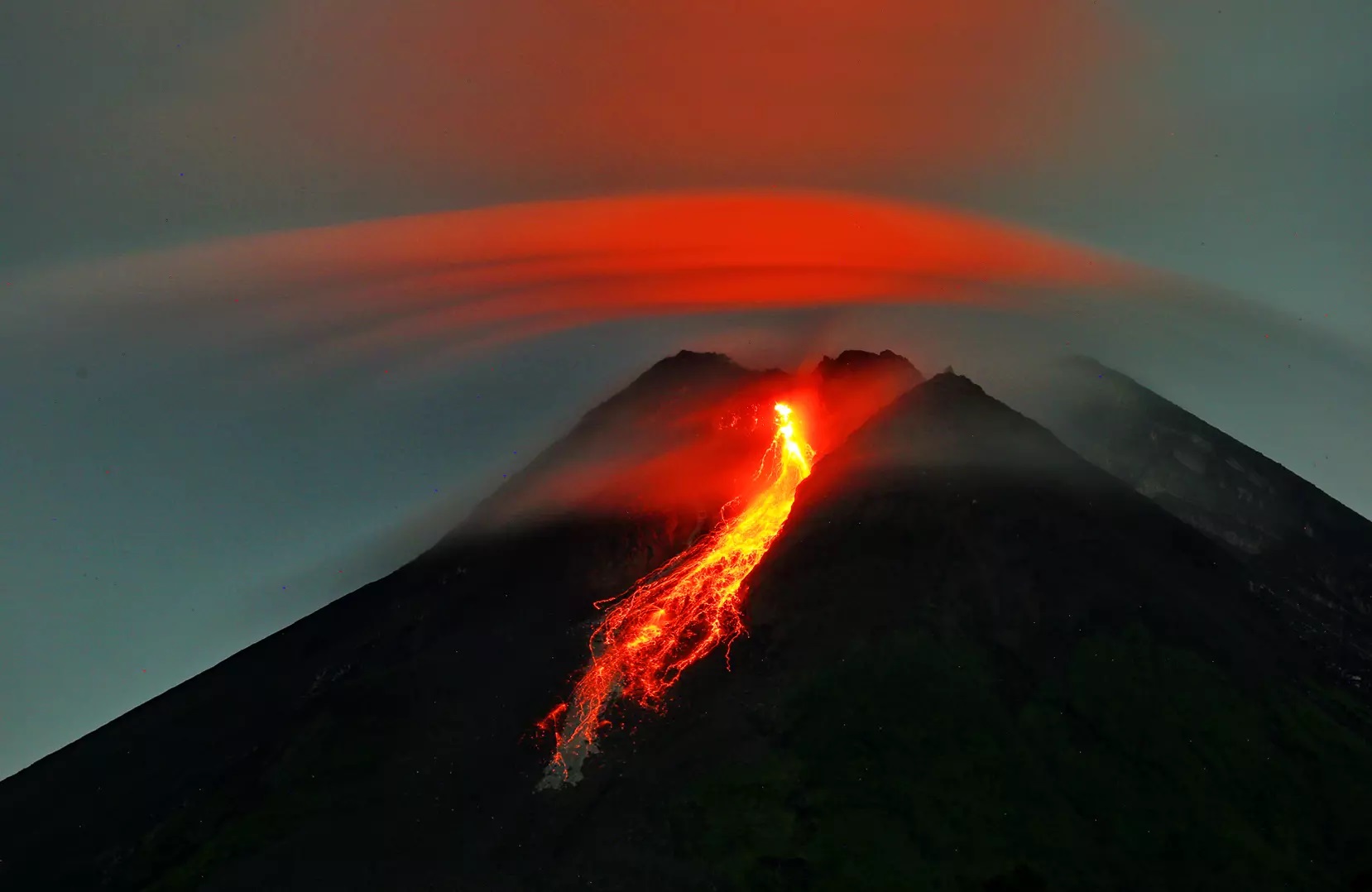
Mount Merapi, located in Indonesia, is one of the most active and dangerous volcanoes in the world. Its name, which translates to "Mountain of Fire," aptly captures its fiery nature and volatile history. This majestic stratovolcano, standing at an impressive 9,550 feet, holds a significant place in the local culture and geological landscape. Its eruptions have left a profound impact on the surrounding environment and communities, shaping the region's history and resilience.
As we delve into 18 fascinating facts about Mount Merapi, we will uncover the geological marvels and historical significance of this iconic volcano. From its explosive eruptions to its spiritual significance in Javanese mythology, Mount Merapi's story is a captivating blend of natural wonder and human perseverance. Join us on this journey to unravel the mysteries and marvels of Mount Merapi, gaining a deeper understanding of the forces that shape our planet and the resilience of those who call its shadowed slopes home.
Key Takeaways:
- Mount Merapi, an active volcano in Indonesia, is known for its frequent and explosive eruptions, making it one of the most dangerous and sacred volcanoes in the world.
- The volcano’s impact on the environment, agriculture, and culture, along with ongoing research and resilient communities, highlight Mount Merapi’s global significance as a natural wonder and site of scientific interest.
Mount Merapi is an Active Volcano
Located in Indonesia, Mount Merapi is an active stratovolcano known for its frequent eruptions. The name "Merapi" translates to "Mountain of Fire" in the Javanese language, reflecting the volcano's intense volcanic activity.
It is one of the Most Active Volcanoes in the World
Mount Merapi is considered one of the most active volcanoes globally, with a recorded history of eruptions dating back to the 16th century. Its frequent and often violent eruptions have earned it a reputation as one of the most dangerous volcanoes on Earth.
The Last Major Eruption Occurred in 2010
In 2010, Mount Merapi unleashed a powerful eruption that resulted in significant devastation across the surrounding region. The eruption claimed hundreds of lives and displaced thousands of people, leaving a lasting impact on the local communities.
Mount Merapi is a Sacred Volcano
The local Javanese people regard Mount Merapi as a sacred and mystical volcano, deeply ingrained in their cultural and spiritual beliefs. The volcano holds significant religious and cultural importance, and various rituals and ceremonies are performed to honor and appease its powerful spirits.
It is a UNESCO World Heritage Site
Mount Merapi and its surrounding area have been designated as a UNESCO World Heritage Site due to its outstanding natural significance and cultural heritage. This recognition underscores the volcano's unique geological features and its profound influence on the local culture and traditions.
Mount Merapi is Part of the Pacific Ring of Fire
As part of the Pacific Ring of Fire, Mount Merapi is situated along the tectonic plate boundaries in the Pacific Ocean. This location makes it prone to volcanic and seismic activity, contributing to its volatile nature and frequent eruptions.
The Volcano's Shape and Structure
Mount Merapi possesses a classic conical shape typical of stratovolcanoes, characterized by steep slopes and a prominent summit. Its structure is composed of alternating layers of solidified lava, volcanic ash, and other volcanic materials accumulated over numerous eruptions.
Mount Merapi's Lava Dome
The volcano is renowned for its prominent lava dome, a large bulge formed by the accumulation of viscous lava within its crater. The lava dome continuously grows and collapses during eruptions, contributing to the volcano's dynamic and ever-changing landscape.
The Volcano's Eruption Style
Mount Merapi exhibits primarily explosive eruptions, releasing a combination of ash, rock fragments, and volcanic gases. These explosive eruptions pose significant hazards to the surrounding areas, including pyroclastic flows, lahars, and volcanic ashfall.
Mount Merapi's Monitoring and Research
Given its high level of activity, Mount Merapi is closely monitored by volcanologists and researchers using various instruments, including seismometers, gas sensors, and satellite imagery. This monitoring helps to assess the volcano's behavior and provides early warnings for potential eruptions.
The Volcano's Impact on the Environment
Mount Merapi's eruptions have a profound impact on the surrounding environment, affecting the local flora, fauna, and ecosystems. The volcanic ash and debris can alter the landscape and soil composition, influencing the region's ecological balance and biodiversity.
Mount Merapi's Influence on Agriculture
The fertile volcanic soils around Mount Merapi support extensive agricultural activities, including the cultivation of rice, vegetables, and fruits. Despite the volcanic hazards, the local communities have adapted to the volcanic landscape and utilize its rich soils for farming.
The Volcano's Tourist Attractions
Despite its active nature, Mount Merapi attracts numerous visitors and adventurers seeking to witness its awe-inspiring beauty and learn about its geological significance. Guided tours and hikes are available, offering unique experiences amid the volcano's dramatic landscape.
Mount Merapi's Cultural Significance
The volcano holds a significant place in Javanese culture and folklore, with numerous myths and legends surrounding its origins and activities. Its spiritual significance is reflected in local traditions, arts, and ceremonies, showcasing the enduring cultural impact of the volcanic landscape.
The Volcano's Ongoing Research and Studies
Mount Merapi continues to be a focal point for scientific research and studies, contributing to our understanding of volcanic behavior and hazards. Ongoing research efforts aim to improve volcanic monitoring, risk assessment, and disaster preparedness in the region.
Mount Merapi's Resilient Surrounding Communities
The communities living in the shadow of Mount Merapi have demonstrated remarkable resilience in the face of recurring volcanic threats. Their ability to adapt, respond, and rebuild in the aftermath of eruptions showcases the human spirit's strength and determination.
The Volcano's Volatile Future
With its history of frequent eruptions and ongoing volcanic activity, Mount Merapi's future remains inherently unpredictable. Continued monitoring, research, and preparedness efforts are crucial to mitigating the potential impact of future eruptions on the surrounding communities and environment.
Mount Merapi's Global Significance
Mount Merapi's unique geological features, cultural importance, and ongoing volcanic activity contribute to its global significance as a natural wonder and a site of scientific interest. Its inclusion as one of the "18 Interesting Facts About Mount Merapi" highlights its enduring impact on the world stage.
Conclusion
Mount Merapi is a captivating and formidable natural wonder, boasting a rich history and unparalleled geological significance. From its explosive eruptions to its cultural importance, Mount Merapi continues to intrigue and inspire awe. Its unique characteristics and impact on the surrounding environment make it a focal point for scientific research and a source of fascination for adventurers and nature enthusiasts alike. As we continue to study and appreciate the complexities of Mount Merapi, we gain a deeper understanding of the Earth's dynamic processes and the delicate balance between human civilization and the natural world.
FAQs
What makes Mount Merapi an active volcano?Mount Merapi is classified as an active volcano due to its frequent eruptions, with the last major eruption occurring in 2018. The volcano's ongoing seismic activity and the continuous release of volcanic gases contribute to its active status.
Is it safe to visit Mount Merapi?Visiting Mount Merapi requires careful consideration of its current activity and guidance from local authorities and experts. While the volcano's allure is undeniable, safety precautions and up-to-date information are essential for anyone planning to explore this remarkable natural wonder.
Was this page helpful?
Our commitment to delivering trustworthy and engaging content is at the heart of what we do. Each fact on our site is contributed by real users like you, bringing a wealth of diverse insights and information. To ensure the highest standards of accuracy and reliability, our dedicated editors meticulously review each submission. This process guarantees that the facts we share are not only fascinating but also credible. Trust in our commitment to quality and authenticity as you explore and learn with us.


